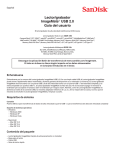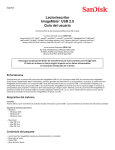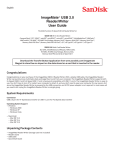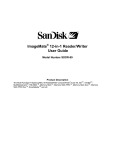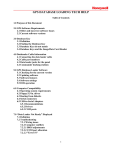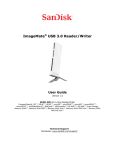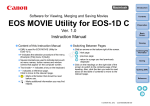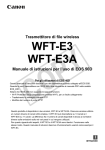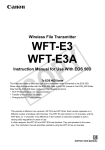Download SanDisk Photo Album Product specifications
Transcript
SanDisk ImageMate ® USB 2.0 Reader/Writer Quick Start Guide Product Description The Multi-Function Hi-Speed USB 2.0 Reader/Writer for: ® SDDR-92: CompactFlash Type I/II SDDR-99: SD, MultiMediaCard, Memory Stick, Memory Stick PRO and xD System Requirements Connection • USB 2.0 port for Hi-Speed data transfer Minimum Operating System Support • Windows o Windows 98SE (driver installation required) o Windows ME o Windows 2000 o Windows XP • Macintosh o Mac OS 9.2+, 10.1.2+ Unpacking Package Contents • • • • ImageMate USB 2.0 Reader/Writer (storage media not included) Installation CD with Windows 98SE driver and button application (Media Card Companion) USB cable Quick Start Guide Checking 1. Unpack the packaging. Make sure you have everything listed in the PACKAGE CONTENTS. 2. Check your system requirements. Refer to SYSTEM REQUIREMENTS or the outside of the packaging. 3. Locate the USB port on your computer. See UNDERSTANDING. Understanding What’s a USB port? The Universal Serial Bus (USB) port is an easy way to connect a new device like the ImageMate USB 2.0 Reader/Writer to your computer. Connecting a device to the USB port doesn’t require that you open your computer to install an add-in card or set complicated switches. You just plug it in and get started. How do I find the USB port? The USB ports are often located on the front or back of your PC, or on a USB hub. On a laptop computer or a Macintosh, the USB port may be located on the side. The USB port looks like this. What is the difference between Hi-Speed USB 2.0 and Full Speed USB 1.1? Hi-Speed USB 2.0 supports the transfer of data up to 480 megabits per second (Mbps), and Full Speed USB 1.1 supports data transfer up to 12 Mbps. Hi-Speed USB 2.0 provides a dramatic improvement in data transfer performance compared to Full Speed USB 1.1. USB 2.0 is backward compatible with USB 1.1 ports. The ImageMate USB 2.0 Reader/Writer supports both USB 2.0 and USB 1.1. Installing Before connecting the ImageMate USB 2.0 Reader/Writer to your computer, you may need to install a device driver. • You can skip this section if your operating system is Windows XP, ME, 2000, Mac OS 9.2+ or Mac OS 10.1.2+ and proceed to Installing the Button Application Install the Windows 98SE Driver 1. Insert the CD included with the ImageMate USB 2.0 Reader/Writer device into the CD-ROM of your computer. 2. Left-click on the START menu and open the RUN menu. Click BROWSE to locate the drive letter of your CD-ROM. 3. Select the \Win98\setup.exe file and click OK. Follow the on-screen directions. Installing the Button Application (Media Card Companion) 1. Insert the CD included with the ImageMate USB 2.0 Reader/Writer device into the CD-ROM of your computer. 2. Left-click on the START menu and open the RUN menu. Click BROWSE to locate the drive letter of your CD-ROM. 3. Select the \Button Application\setup.exe file and click OK. Follow the on-screen directions. Connecting Connecting the ImageMate USB 2.0 Reader/Writer to the USB port is simple. You don’t need to turn off or restart your computer when attaching the ImageMate USB 2.0 Reader/Writer. Since the ImageMate USB 2.0 Reader/Writer is powered by the USB connection, an AC/DC power adapter is not needed. • Before connecting the ImageMate USB 2.0 Reader/Writer, complete the device driver installation. See INSTALLING. Use the USB cable to connect your ImageMate to the computer directly. When the ImageMate USB 2.0 Reader/Writer is connected for the first time, your computer may display a message that the device is being installed (may vary slightly depending on your operating system). Windows Disk Icons When you connect the ImageMate USB 2.0 Reader/Writer on a Windows operating system, a newly assigned removable disk icon drive letter representing the card slot will be shown in My Computer. Macintosh Disk Icons When you connect the ImageMate USB 2.0 Reader/Writer on a Macintosh operating system, a removable disk icon labeled “untitled” representing the card slot will show on the desktop when a card is inserted. Using The ImageMate USB 2.0 Reader/Writer has one card slot that is used for different types of cards. • • SDDR-92: CompactFlash Type I /II SDDR-99: SD, MultiMediaCard, Memory Stick, Memory Stick PRO and xD Inserting Cards To insert a card into the ImageMate USB 2.0 Reader/Writer slot, insert the connecter end of the card with the card label side facing up. DO NOT force the card into the slot. LED Activity SDDR-92 (CompactFlash Reader/Writer): • Windows XP: The LED indicator turns on when a card is inserted correctly. • Windows 98SE/ME/2000: The LED indicator turns on when double-click on "Removable Disk" when a card is inserted correctly. • Macintosh OS: A drive icon appears on the desktop when a card is inserted correctly. • All operating systems: The LED indicator blinks when data is transferred from or to the card. SDDR-99 (5-in-1 Reader/Writer): When the ImageMate USB 2.0 Reader/Writer is installed correctly, the GREEN LED turns on. If the LED is not on: • Check to make sure the ImageMate USB 2.0 Reader/Writer is connected and the card is inserted properly. The activity LED indicator (orange) blinks when data is transferred from or to the card. NEVER remove the card when the ACTIVITY LED is FLASHING or BLINKING Using it on a PC with the button application 1. 2. 3. 4. Insert the Media Card Press the button on the reader The Media Card Companion application will load If you wish to save the files to your PC choose the “Transfer all Files” button. This will allow you to either copy or move the files to the PC 5. If you wish to Select, Rename, Print, E-mail or use for Screen Saver any or all of the photos choose the “Use Photo Tools” Icon. Using it on a PC without the button application Here is the way to create a Folder on your Desktop and Copy and Paste your photos to it. 1. How to create a FOLDER on your Desktop A. Place your mouse pointer somewhere on the Desktop but not on an icon. B. Click once with the RIGHT mouse button, move your mouse pointer over NEW then click FOLDER with the LEFT mouse button. C. This will create a NEW FOLDER on your Desktop. At this time you can name anything you like, i.e. My Pictures or Photos, by typing the name in. When you are finished typing press the ENTER key on your keyboard. Now the folder name is saved. 2. How to copy and paste your photos into a folder A. Double click on the icon "My Computer". B. Double click on the removable disk drive (for the ImageMate USB 2.0 Reader/Writer), i.e. F: or G: or maybe E: Now you should see a DCIM folder (that stands for Digital Camera Images). C. Double click on the DCIM folder. Now you should see your camera folder, i.e. 100Olymp or 100Canon or 100Fuji D. Double click on the camera folder. Now you should see your pictures or picture file names (depending on what Operating System you are using). E. Go up to the menu bar where it says "EDIT" and click on "SELECT ALL". You will see all your pictures HIGHLIGHTED. F. Go back to "EDIT" and now click "COPY". Close or minimize this window. G. Double click on the folder you created on your Desktop, go to "EDIT" then click "PASTE" and you should see the pictures being copied to the folder. H. To View your Pictures Double click on the File name and the Picture will open up Using it on Macintosh without the button application (The button application is not compatible with the Macintosh operating systems) 1. Connect the ImageMate USB 2.0 Reader/Writer to the USB port on your Mac (do not connect to Monitor or Keyboard). 2. To transfer files place a card into the Reader/Writer unit. A new drive will appear on your desktop called “untitled”. 3. Drag and drop files to and from the new drive as you would to any other disk or folder. Removing Card To remove the card in Windows: 1. Double click on the icon "My Computer" 2. Right-click on the corresponding ImageMate USB 2.0 Reader/Writer drive icon 3. Select Eject (this is not needed for Windows 98SE or XP) 4. Pull the card out of the slot To remove the card on a Macintosh: 1. Drag the “untitled” icon into the Trash 2. Pull the card out of the slot Disconnecting You don’t need to shut down your computer to disconnect the ImageMate USB 2.0 Reader/Writer, but you should NEVER remove the device from the USB port without first reading the steps below. If a drive window is open or the ImageMate USB 2.0 Reader/Writer is active, close any associated windows before attempting to remove the ImageMate. Windows Use the hotplug icon in the notification area of the taskbar to safely stop the device before unplugging it. The notification area is on the right side of the taskbar where you usually see the time displayed. • These steps are not required for Windows 98SE or XP 1. In the notification area, right-click on the hotplug icon 2. Select the device you want to unplug then click STOP 3. When Windows notifies you that it is safe to do so, unplug the ImageMate USB 2.0 Reader/Writer from your computer Macintosh 1. Drag the ImageMate USB 2.0 Reader/Writer “untitled” icon into the Trash. 2. Unplug the device. Troubleshooting For FAQs on error messages please go to our website at http://www.sandisk.com/retail/support.asp For assistance by phone please call toll free 866-SANDISK (866-726-3475) M-F 7AM till 4 PM PST Limited Warranty SanDisk warrants the ImageMate USB 2.0 Card Reader/Writer to meet all the published product specifications and to be free of any defects in materials or workmanship that would prevent them from performing to published product specifications for two years from the date of purchase. This express warranty is extended by SanDisk Corporation, 140 Caspian Court, Sunnyvale, CA 94089. SanDisk’s products are not warranted to operate without failure. Accordingly, in any use of the products in life support systems or other applications where failure could cause injury or loss of life, the products should only be incorporated in systems designed with appropriate redundancy, fault tolerant or back-up features. This product is intended for consumer end-use only; it is not intended for nor warranted for commercial applications. You may register your product online at http://www.sandisk.com/registration SanDisk Corporation general policy does not recommend the use of its products in life support applications where in a failure or malfunction of the product may directly threaten life or injury. Per SanDisk Terms and Conditions of Sale, the user of SanDisk products in life support applications assumes all risk of such use and indemnifies SanDisk against all damages. The information in this manual is subject to change without notice. SanDisk Corporation shall not be liable for technical or editorial errors or omissions contained herein; nor for incidental or consequential damages resulting from the furnishing, performance or use of this material. All parts of SanDisk documentation are protected by copyright law and all rights are reserved. This documentation may not, in whole or in part, be copied, photocopied, reproduced, translated or reduced to any electronic medium or machine-readable form without prior consent, in writing, from SanDisk Corporation. SanDisk and the SanDisk logo are registered trademarks and ImageMate is a trademark of SanDisk Corporation. CompactFlash is a U.S. registered trademark of SanDisk Corporation. SanDisk is an authorized licensee of the SD trademark. Memory Stick is a registered trademark of Sony Corporation. SmartMedia is a trademark of Toshiba Corporation. The USB-IF Logo is a trademark of Universal Serial Bus Implementers Forum, Inc. Product names mentioned herein are for identification purposes only and may be trademarks and/or registered trademarks of their respective companies. © 2004 SanDisk Corporation. All rights reserved. Printed in China. SanDisk products are covered or licensed under one or more of the following U.S.Patent Nos. 5,070,032; 5,095,344; 5,188,485; 5,172,338; 5,198,380; 5,200,959; 5,288,318; 5,288,870; 5,272,889; 5,418,752. Other U.S. and foreign patents awarded and pending.







